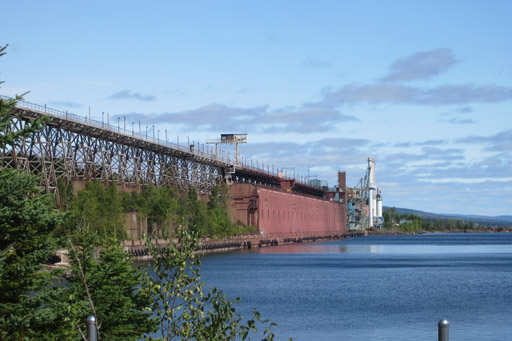About six years ago I was on a motor trip along the North Shore of Lake Superior, and wandered down a small road from the highway down to the lake. When I parked in the small recreational harbor, I saw this huge abandoned facility along the shoreline. (It’s much bigger than it looks in this photo, with nothing to give ir scale.) As a Duluth native, I knew ore-loading docks when I saw them, but I’d never seen or heard of the place before. It wasn’t on any map. And it was empty.
Turns out it was a place called Taconite Harbor, which once included the docks, a power plant, and a small town purpose-built to serve the harbor. It existed from the Fifties into the Eighties, and then the town was not only abandoned, but shipped out— they literally carried the houses away on trucks.
Taconite is a type of ore in which the iron is bound up with hard minerals such as quartz, ands it’s very difficult to mine— it’s too hard to mine with a big shovel or scoop, you have to blow up huge reefs of the stuff with dynamite. When the natural iron formations began to run out on Minnesota’s Iron Range, the mining companies turned to taconite as a substitute beginning in the 1950s. A big industrial plant was required to get the iron out of the rock. First the ore is powdered by steel bars rolling in huge barrels, then the iron is extracted by electromagnets, after which it’s mixed with some other stuff to turn it into pellets, which are put into Great Lakes ore boats (never “ships,” no matter how big they get), and carried through the Soo Locks to blast furnaces in Ohio or Michigan or wherever.
Back in the Fifties, Erie Mining built a taconite plant at Hoyt Lakes and a proprietary railroad that ran to the docks at Taconite Harbor, which they also built. Erie built the town to service the docks, and imported prefabricated three- and four-bedroom homes, along with a community center, fire station, school, and power plant. The houses had green lawns, asphalt driveways, and a whole forest in their backyards— much like the homes in which I spent my childhood.
Families could buy the houses for $400 down and $100 per month, then commence their 1950s idyllic lifestyle.
Disadvantages to the location were the noise made by ships and trains, and by the enormous clouds of taconite dust, reminiscent of the Dust Bowl, that rose on a strong wind. The dust could literally paint the town red.
Taconite tailings also contain cummingtonite-grunerite, which is a kind of proto-asbestos that can form asbestos under certain conditions. Miners and dock workers have developed mesothelioma and other lung conditions, but because so much asbestos was used in mining those days, it’s not been proven that the tailings were responsible.
Which is where this story touches me. The Reserve Mining Company’s taconite plant at Silver Bay dumped their tailings directly into Lake Superior, which is where Duluth and other town drew their drinking water. I spent part of my youth drinking asbestos water, and perhaps as a consequence I’ve had stomach problems my adult life.
The court-ordered cleanup of the Silver Bay tailings was one of the costliest environmental cleanup projects in history.
Reserve Mining has a cannonball-shaped mascot called “Rocky Taconite.” When I see him, I’m not amused.
By the 1980s, Erie Mining had been absorbed by LTV Steel, which decided it no longer wanted to be a landlord. Homeowners in Taconite Harbor were sold their homes for $1 on condition that they be moved to anyplace other than Taconite Harbor. A developer bought any unsold buildings and moved them out piecemeal to wherever lots were available. Shortly afterward, LTV Steel declared bankruptcy and the harbor itself was abandoned, except as a mooring site for small craft.
This is a typical story for a mining district. Mining companies make a strike, dig ore, create a town . . . and then the ore runs out and the town is abandoned, or the pit grows so big that it consumes the town. Where I now live in New Mexico, the landscape is full of old mining sites that have either been abandoned, or reduced to a fraction of their original size. Sometimes there are abandoned or half-abandoned cemeteries, overgrown and in the shadow of a half-wrecked church.
There are also abandoned railroad junctions, built to service the railways that connected the mining sites. When the miners went away, so did the need for the railroads. The tracks were taken up and the junctions left to the ghosts.
I was deeply impressed by the enormous amount of money and industry that went into docks that were to be abandoned only a few decades after being built— and the docks were just a small part of the whole industrial complex. There is no better illustration of Shumpeter’s “creative destruction” than a mining district.
